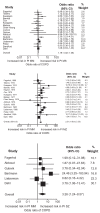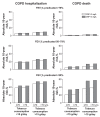Markers of early disease and prognosis in COPD
- PMID: 19436688
- PMCID: PMC2672792
- DOI: 10.2147/copd.s3106
Markers of early disease and prognosis in COPD
Abstract
COPD is a complex disease with multiple pathological components, which we unfortunately tend to ignore when spirometry is used as the only method to evaluate the disorder. Additional measures are needed to allow a more complete and clinically relevant assessment of COPD. The earliest potential risk factors of disease in COPD are variations in the genetic background. Genetic variations are present from conception and can determine lifelong changes in enzyme activities and protein concentrations. In contrast, measurements in blood, sputum, exhaled breath, broncho-alveolar lavage, and lung biopsies may vary substantially over time. This review explores potential markers of early disease and prognosis in COPD by examining genetic markers in the alpha(1)-antitrypsin, cystic fibrosis transmembrane conductance regulator (CFTR), and MBL-2 genes, and by examining the biochemical markers fibrinogen and C-reactive protein (CRP), which correlate with degree of pulmonary inflammation during stable conditions of COPD. Chronic lung inflammation appears to contribute to the pathogenesis of COPD, and markers of this process have promising predictive value in COPD. To implement markers for COPD in clinical practice, besides those already established for the alpha(1)-antitrypsin gene, further research and validation studies are needed.
Figures









References
-
- Pauwels RA, Buist AS, Calverley PM, Jenkins CR, Hurd SS. Global strategy for the diagnosis, management, and prevention of chronic obstructive pulmonary disease. NHLBI/WHO Global Initiative for Chronic Obstructive Lung Disease (GOLD) Workshop summary. Am J Respir Crit Care Med. 2001;163:1256–1276. - PubMed
Publication types
MeSH terms
Substances
LinkOut - more resources
Full Text Sources
Other Literature Sources
Medical
Research Materials
Miscellaneous

